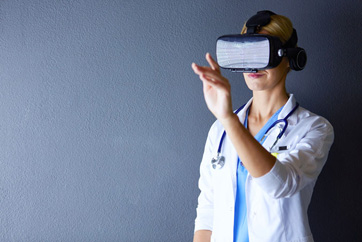Virtual reality enhances CV care, education

Advancements in virtual reality have given physicians the ability to learn quickly, interpret images accurately and complete interventions in less time, according to a review published in JACC: Basic to Translational Science.
“For years, virtual reality technology promised the ability for physicians to move beyond 2D screens in order to understand organ anatomy noninvasively,” Jennifer N.A. Silva, MD, assistant professor of pediatrics and cardiology at Washington University School of Medicine in St. Louis, said in a press release. “However, bulky equipment and low-quality virtual images hindered these developments. Led by the mobile device industry, recent hardware and software developments — such as head-mounted displays and advances in display systems — have enabled new classes of 3D platforms that are transforming clinical cardiology.”
Different visual options
VR allows the wearer to interact within an environment to provide a visual and auditory experience, which has been utilized in exposure therapy, pain management, education, stroke rehabilitation and surgical planning. In contrast, augmented reality placed 2D or 3D images on top of a native environment with minimal interference of field of vision. This has been used in patient point of care, emergency response, education and telemedicine.
Both of these provide two different types of experiences: merged reality and mixed reality.

“Both approaches achieve a similar experience to allow for interaction with digital objects while preserving a sense of presence within the true physical environment,” Silva and colleagues wrote.
Educational and training applications can be enhanced by VR by simulating an operating environment with educational material. Mixed reality allows multiple wearers to discuss and interact with each other while viewing educational material.
Not only can VR be used to educate medical students and trainees, but also patients and their families to learn more about a child’s cardiac anatomy, according to the review.
A 3D monitor can be used in the cardiothoracic operating room to accurately access intracardiac anatomy and geometry.
Through 3D visualization, preprocedural planning can be enhanced by allowing physicians to visualize arteries in patients with pulmonary atresia among other conditions, according to the review. One study found that the addition of 3D visualization to the planning process sped up interpretation times to 13 minutes compared with 22 minutes using a traditional display.
Visualization can also be used during a procedure and can display data that were obtained before a procedure such as cardiac MRI or CT. The interventionalist can control this model through gaze, gesture or voice control, allowing sterile control of the display.
Patients after a stroke can participate in rehabilitation through a combination of brain imaging, VR and gaming technologies to improve upper-limb mobility by retraining the brain.
Advancements in technology
Various available systems and future devices can expand the use of VR to improve patient care, including displays. Monocular systems display information outside the normal working visual field, whereas biocular displays show two different images. Other technology includes 3D displays, light field displays, interference-based holography and waveguides.
Even with advancements in this field, there are some challenges regarding implementation.
“Extended reality platforms are constrained primarily by cost, size, weight and power to achieve the highest visual quality, mobility, processing speed and interactivity,” Silva and colleagues wrote.
Although challenges may arrive, technology like AR and mixed reality offer physicians a clear field of view through digital annotation.
“These improvements in physician performance based on better information will most likely translate into lower-cost procedures and better outcomes for patients,” Silva and colleagues wrote. – by Darlene Dobkowski
Disclosures: Silva reports she is on the board of directors of and is a consultant for SentiAR. Please see the study for all other authors’ relevant financial disclosures.
